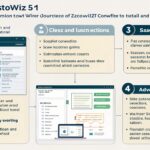In today’s fast-paced digital world, organizations seek efficient ways to manage tasks and data. CILFQTACMITD is a powerful framework designed to streamline operations through collaboration, integration, and automation.
Though the acronym may seem complex, its principles are simple and effective. It promotes quick task automation and real-time data tracking across teams.
This guide explores what CILFQTACMITD stands for, how it works, and why it matters.
What Does CILFQTACMITD Stand For?
CILFQTACMITD stands for Collaborative, Integrated, Low Friction Quick Task Automation for Coordinated Management of Information Tracking and Data. This acronym encapsulates a system designed to enhance business operations through seamless integration and collaboration. It focuses on automating repetitive tasks quickly while minimizing user friction. The system coordinates data management across teams, ensuring information is tracked efficiently. With real-time insights, it supports decision-making and operational alignment. Ultimately, CILFQTACMITD improves both workflow efficiency and data accuracy.
Core Components of CILFQTACMITD
Collaborative:
Collaborative in CILFQTACMITD emphasizes teamwork and shared responsibility, fostering a cooperative work environment. It enables seamless communication and data sharing among teams for better outcomes.
Integrated:
Integrated in CILFQTACMITD refers to the seamless connection of various systems and processes within an organization. It ensures smooth data flow, enhancing efficiency and reducing silos between teams.
Low Friction:
Low friction in CILFQTACMITD refers to minimizing barriers in system usage, making it intuitive and easy for users. It ensures smooth interactions and quick adoption across teams without complex setups.
Quick Task Automation:
Quick task automation in CILFQTACMITD streamlines repetitive processes, reducing manual effort and errors. It accelerates task completion, freeing up resources for more strategic activities.
Coordinated Management:
Coordinated management in CILFQTACMITD ensures alignment across teams and processes, driving synchronized efforts towards common goals. It integrates workflows, enhancing efficiency and collaboration within the organization.
Information Tracking:
Information tracking in CILFQTACMITD involves continuously monitoring data across various systems in real-time. This enables businesses to maintain accurate records and gain valuable insights into operations. Effective tracking ensures that all teams are aligned and informed for better decision-making.
Data:
Data in CILFQTACMITD refers to the information tracked and managed across systems in real-time. It ensures that all decision-making processes are based on accurate, up-to-date insights. Effective data management enables seamless integration, task automation, and improved collaboration across teams.
Applications of CILFQTACMITD
CILFQTACMITD finds its utility across various sectors:
- Healthcare: Streamlining patient data management and enhancing interdepartmental communication.
- Manufacturing: Optimizing production lines through real-time data tracking and automated task scheduling.
- Finance: Facilitating quick decision-making by integrating financial data and automating routine analyses.
- Retail: Managing inventory and customer data efficiently, leading to improved customer service and satisfaction.
Benefits of Implementing CILFQTACMITD
Implementing CILFQTACMITD boosts organizational efficiency by automating repetitive tasks, saving time and reducing errors. It fosters better collaboration through integrated systems, enhancing communication across teams. Real-time data tracking provides valuable insights for informed decision-making. The system’s low friction design ensures ease of use, promoting smoother adoption. It also supports scalability, adapting to growing business needs. Overall, it streamlines operations and boosts productivity, driving long-term success.
Challenges and Considerations
Implementing CILFQTACMITD can involve high initial costs for integration and staff training. Resistance to change from employees may slow adoption. Ensuring data security and compliance with regulations is critical. Customizing the system to fit unique business needs can be complex. Continuous maintenance and updates are essential for long-term success.
Future of CILFQTACMITD
The future of CILFQTACMITD looks promising as businesses continue to prioritize automation and data-driven decision-making. Its ability to integrate with AI and machine learning will enhance predictive capabilities. As remote and hybrid work models grow, its collaborative features will become even more essential. Advancements in cloud technology will further simplify deployment and scalability. Overall, CILFQTACMITD is set to become a cornerstone in modern digital transformation strategies.
Frequently Asked Questions (FAQs)
1. What does CILFQTACMITD stand for?
CILFQTACMITD stands for Collaborative, Integrated, Low Friction Quick Task Automation for Coordinated Management of Information Tracking and Data. It combines automation, data management, and collaboration into one cohesive system.
2. Who can benefit from CILFQTACMITD?
Businesses of all sizes across industries like healthcare, finance, manufacturing, and retail can benefit. It enhances productivity, data accuracy, and collaboration.
3. Is CILFQTACMITD difficult to implement?
Implementation may require planning, customization, and training. However, once set up, it significantly boosts efficiency.
4. Does CILFQTACMITD support remote teams?
Yes, it facilitates seamless communication and task tracking across distributed teams. Many platforms also offer mobile and cloud-based access.
5. How does CILFQTACMITD improve decision-making?
By offering real-time data tracking and analytics, it supports timely and informed decisions. This leads to better outcomes and resource allocation.
6. Can it be integrated with existing software systems?
Yes, most CILFQTACMITD frameworks are built to integrate with existing tools and platforms. This reduces disruption during transition.
7. Is CILFQTACMITD scalable for growing businesses?
Absolutely, its modular and flexible nature allows easy scaling. It can grow alongside your organization without major overhauls.
8. How does it handle data security?
It uses centralized control and encryption protocols to safeguard data. Access permissions and audits help ensure data integrity.
9. Does CILFQTACMITD replace human roles?
No, it supports human efforts by automating repetitive tasks. It allows staff to focus on strategic and creative work.
10. What are the first steps to adopting CILFQTACMITD?
Start with a needs assessment and set clear goals. Then choose a compatible platform and invest in team training.
Conclusion
CILFQTACMITD offers a modern solution to streamline task management and data coordination. Its focus on collaboration, low friction, and automation makes it ideal for dynamic business environments.
By integrating systems and tracking information in real-time, it supports smarter, faster decision-making. While implementation may require initial effort, the long-term benefits are substantial.
As digital transformation accelerates, frameworks like CILFQTACMITD will become essential. Embracing it today can future-proof your organization for tomorrow.
















+ There are no comments
Add yours